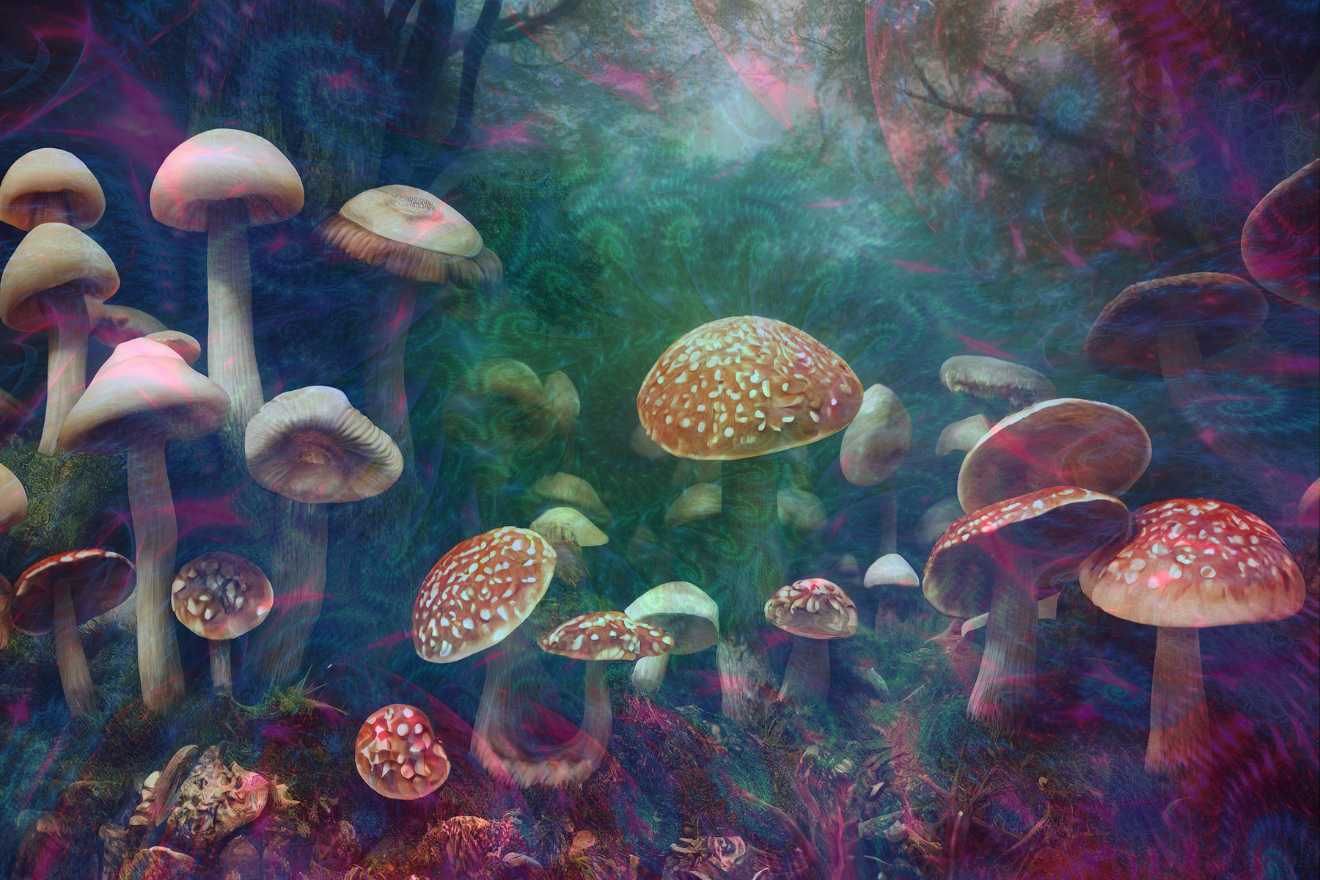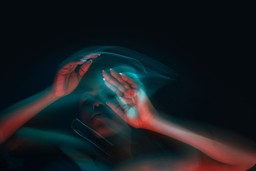We need to talk about Hallucinogen Persisting Perception Disorder (HPPD). Characterized by persistent and distressing visual disturbances following the use of drugs such as LSD, psilocybin, or DMT, HPPD has received relatively little attention from researchers and healthcare providers. And while its symptoms are neither necessarily distressing nor uncommon – the so-called ‘subclinical’ end of the spectrum – serious HPPD is a considerable risk factor for anxiety and depression, debilitation and dysfunction, alcoholism and substance abuse, and even suicide.
The symptoms of Hallucinogen Persisting Perception Disorder are diverse and wide-ranging. But there’s a characteristic set of symptoms by which most are affected: visual static (or an enhancement thereof), trails, illusions of movement (think ‘melting’ or ‘breathing’ walls), geometric shapes, halos around lights and objects, afterimages, alterations in color perception, and possibly an intensified number of floaters. Some experience tinnitus and usually mild auditory hallucinations, and others report more exotic hallucinations like zoomorphism, anthropomorphism, and pareidolia: or the perception of faces on surfaces.
Another frequent part of the package is depersonalization-derealization (DP/DR), a dissociative-anxious condition in which people feel distanced from themselves and their bodies, and the world around them feels dream-like and fake. As we’ll see later, DP/DR and the direct visual symptoms of HPPD seem to run in multidirectional and mutually reinforcing ways, with anxiety a pesky substrate in the middle to link them.
For a condition defined centrally around hallucinogens – itself, an increasingly outmoded term – HPPD (or similar effects) have been linked to different classes of drugs, and those that have been reported to cause HPPD include:
- Psychedelics: LSD, psilocybin
- Dissociatives: PCP, ketamine, DXM
- Cannabis and synthetic cannabinoids
- MDMA (Ecstasy)
- Deliriants: DPH
- SSRIs: Fluoxetine, Sertraline, Paroxetine, etc.
- Antipsychotics: Risperidone
How common is it?
Estimates of the prevalence of Hallucinogen Persisting Perception Disorder are limited, but it may affect as many as 1 in 25 lifetime users of psychedelics. This is based on a 2011 study conducted by Dr. Matthew Baggott (Co-founder of Tactogen) together with colleagues at Erowid. Among some 2,500 individuals recruited via the Erowid site (whose drug use is biased in the heavier direction), more than 60% reported some lasting visual aberrations, while 4.2% suggested their visual effects were severe enough to warrant a possible consultation with a doctor.
HPPD prevalence is muddied by likely under- or misdiagnosis. Some may be misdiagnosed with psychosis spectrum disorders or mere anxiety. Getting a solid line on what is going on may be especially difficult in non-English speaking countries or elsewhere in places less acculturated by clinical neutrality towards drugs and harm reduction approaches. In clinical trial settings, full-blown HPPD has not yet occurred, but cases along the borders of the diagnosis unfortunately have.
The Cover Story/Power Trip podcast revealed that a participant in a MAPS MDMA trial developed lasting visual hallucinations, albeit ones that evolved to become non-distressing. The HPPD Foundation I work with has been in contact with a participant in a Canadian psilocybin trial. Their HPPD began in mild form after their third dose and was later exacerbated into a more full-blown case by later dosing with an underground therapist and a legal ketamine infusion. Other ‘sub-clinical’ ‘flashback phenomena’ have occurred in trials in Switzerland with MDMA, LSD, and psilocybin, and interestingly at similar degrees of frequency.
What causes Hallucinogen Persisting Perception Disorder?
The underlying causes of HPPD are still not well understood, but a number of theories have been proposed. One theory suggests that HPPD may be related to a drug-induced enhancement in the excitability of the visual cortex. This is complemented by an alteration to the release of GABA, which is involved in regulating visual noise. It is as if the normal filters of visual perception are loosened, introducing more ‘noise’ to what HPPDers see.
HPPD may be related to neuroplasticity or the ability of the brain to reorganize itself in response to changes in sensory input. Psychedelics are powerful psychoplastogens, and it’s possible that the changes they induce in perceptual function last beyond the drug’s acute effects – in parallel to how neuroplastic changes in mood or cognitive function can last for several weeks in the ‘afterglow’ phenomenon.
Diagnostic Challenges and Overlaps with Other Conditions
The state of ‘HPPD’ in psychiatric classification is decidedly confused. HPPD is diagnosed when other possible confounds are ruled out, including generalized anxiety disorder, depersonalization-derealization disorder, or PTSD. It’s not clear, however, especially since HPPD is defined by distress and often follows traumatic experiences when HPPD would be a preferred diagnosis. It is possible that HPPD’s striking visual symptoms blur the richer phenomenology at play: note that Abraham, the originator of HPPD, focused on his patient’s visual symptoms over and above their cognitive and affective ones because they were more unique and easier to describe.
As above, a wide variety of non-hallucinogenic drugs can prompt these symptoms, too. Yet DSM-5 criteria establish the condition as hallucinogen-specific: one of ‘re-experiencing’ the visual phenomena glimpsed while tripping. But clinical reports have also made clear for some time that HPPD symptoms are not necessarily ‘re-experiences’ but are often novel visual aberrations that occurred after the drug experience. This is further complicated by the significant overlap of HPPD with other conditions, including Lyme disease, Visual Snow Syndrome (VSS), temporal and occipital lobe epilepsy, and migraine with aura. VSS especially can present identically to HPPD, including characteristic clusters of visual static, after-images, haloes, anxiety, tinnitus, and dissociation.
Exploring the Complexity of Visual Snow Syndrome (VSS)
Even classically psychedelic phenomena like geometric patterns and illusions of movement, which one may ascribe more to HPPD, can occur in VSS. VSS’s aetiology is not very well understood. People can have these symptoms from birth, after a bad migraine episode, head injury, infection, or a period of intensive stress and anxiety. While there is some evidence of differences between HPPD and VSS, HPPD’s lack of proper definition makes strict comparisons difficult. Different aetiologies could prompt different Visual Snow Syndromes with different symptoms, but sub-comparisons based on the causes of defined VSS have not been made.
Overlapping Syndromes and Their Implications
This means that many people’s ‘HPPD’ may be better defined as drug-induced VSS. This would have the benefit of reducing stigma and tapping into growing awareness and funding for VSS, and preventing the internalization of a ‘never-ending trip’ narrative that can occur with HPPD. It’s crucial to remember, though, that some people’s experiences do follow the ‘re-experiencing’ criteria more closely and bear little resemblance to VSS. Hallucinogen Persisting Perception Disorder may therefore comprise a range of syndromes requiring further elucidation.
From its definition outwards, though, VSS technically disqualifies the role of any psychotropic substance in its aetiology. The clinical and lay literature around HPPD has evolved in parallel to consider condition one of ‘drugs’ in the abstract, which is still separate from VSS and others. Needless to say, though, ‘drugs’ encompass a vast range of neurochemical and psychophysical effects that resist homogenous categories. Indeed, even drug use in the last year—despite significant possible elapses of time in the onset of symptoms—has been taken to disqualify for VSS diagnosis and instead merit ‘HPPD.’ This blankets over the possible non-drug factors that could play a role, including even diet and nutritional deficiencies. Boundary cases are already emerging. Some individuals report triggering symptoms akin to VSS and HPPD through the use of SSRIs; at least one clinical report has described this possibility as ‘drug-induced VSS’ and explicitly connected HPPD and VSS.
Cohen and Dittman (1963) noted that psychedelic experiences – or simulations engendered by placebo! – can form easy events on which to center later developments, both positive and negative. Blaming a drug experience possibly taken months ago would seem sensible, not least with the ‘visuals’ concomitant to the new condition.
Identifying Genetic Vulnerabilities and Environmental Triggers
It is curious that some consistent VSS symptoms may occur for around 3.7% of the general public; more transient and contingent symptoms are probably much higher. This is close to the 4.2% figure estimated by Baggott for debilitating HPPD symptoms among psychedelic users, which suggests a pre-existing vulnerability, perhaps on genetic lines.
Abraham (1983) suggested that this genetic vulnerability may be activated on an exposure-dependent basis – not to mention the importance of the trips’ actual content, emotional character, and valence. As noted since the earliest ‘flashback’ literature, it seems that these experiences may be more common after challenging, if not traumatic, trips, such that HPPD could sometimes be an instance of PTSD. Recall, though, that Baggott found a general prevalence of 60.6% of aberrant visual phenomena, suggesting that drugs are playing a larger role than simple biomechanics of vulnerability and stress.
Follow your Curiosity
Sign up to receive our free psychedelic courses, 45 page eBook, and special offers delivered to your inbox.Interplay Between Psychedelics, Neurochemistry, and Vulnerabilities
The famous 5-HT2A receptor has been linked specifically with anxiety in limited studies with rodents. We also know that anxiety and nervous system arousal can have a significant impact on the creation of visual disturbances in the absence of any drug use. Indeed, when someone takes a psychedelic drug, it results in a dramatic increase in the levels of serotonin in the brain, with downstream effects on regulating mood, perception, and cognition and secondary effects on other neurotransmitter systems like the noradrenergic and GABAergic systems. The role of the serotonergic system may also explain why drugs like MDMA and SSRIs can cause HPPD-like effects and prompted the visual hallucinations researcher Dominic Ffytche to class HPPD as one among many ‘serotonergic syndromes.’ Three regarded researchers on HPPD have linked the condition to a “subtle over-activation of predominantly neural visual pathways, [which] worsens anxiety after ingestion of arousal-altering drugs, including non-hallucinogenic substances.”
As noted above, the relationship between Hallucinogen Persisting Perception Disorder and psychedelics is not well understood, either. It’s not clear which drugs provoke these effects more than others, but LSD is the leading cause in clinical case reports, followed shortly by cannabis, which perhaps reflects the drugs’ incidental popularity in naturalistic settings. It’s likely that other factors, such as individual differences in drug metabolism and dose, will play a role in the development of HPPD. For instance, 5-MeO-DMT is known to create ‘re-activations’ at relatively high prevalence among its users: vivid re-experiences of the drug’s effects that seem like classical flashbacks and which tend to be positive or neutral in character. Why 5-MeO-DMT does this more than other drugs deserves more exploration, as does the possibility of different psychedelics creating consistent subspecies of ‘HPPDs.’
What helps Hallucinogen Persisting Perception Disorder?
In terms of treatment, options that meet a gold standard of evidence for individuals with HPPD are limited. Currently, no FDA-approved treatments are available for HPPD, and the most effective approaches are still not well understood. However, some case reports suggest that psychotherapy, particularly cognitive-behavioral therapy combined with anxiety reduction, may be beneficial for some individuals with HPPD. Anecdotally, many people with HPPD report improvement with lifestyle modifications, such as reducing stress, getting regular exercise, and avoiding triggers like drugs and medications that may exacerbate their symptoms.
Despite the challenges posed by Hallucinogen Persisting Perception Disorder, there is hope for those affected by this condition. The Perception Restoration Foundation is an organization dedicated to increasing awareness and understanding of HPPD and to promoting research into effective treatments. The PRF’s Specialists Directory showcases a directory of mental health professionals with prior experience and relevant expertise in treating the condition.
The PRF Information Guide provides information on the medications that are typically prescribed for HPPD, including Lamotrigine and benzodiazepines, as well as overviews of everything we know and don’t know about the condition. It’s important to note that the treatment for HPPD will vary from person to person. Some report deterioration in their symptoms through antipsychotics and SSRIs, for instance, while others report benefits.
Sponsored by the PRF, I am conducting a new questionnaire study to better understand the different factors that create distress with HPPD. The study investigates the relationship between thoughts and behaviors, psychoeducation, and symptom intensity in driving distress in HPPD, which has been neglected as a clinical indicator. Individuals who encounter HPPD patients are encouraged to forward the study link to them for completion. If any issues arise, participants are advised to contact me at u2252270@uel.ac.uk.
References
- Lewis, D. (2020). Faces of HPPD: Hallucinogen Persisting Perception Disorder Patient Survey Results and a Descriptive Analysis of Patient Demographics, Medical Background, Drug Use History, Symptoms, and Treatments. Addictive Disorders & Their Treatment 19(1):p 36-51, March 2020. | DOI: 10.1097/ADT.0000000000000178
- COHEN, S., & DITMAN, K. S. (1963). Prolonged adverse reactions to lysergic acid diethylamide. Archives of General Psychiatry, 8, 475–480. https://doi.org/10.1001/archpsyc.1963.01720110051006
- Ffytche D. H. (2007). Visual hallucinatory syndromes: past, present, and future. Dialogues in clinical neuroscience, 9(2), 173–189. https://doi.org/10.31887/DCNS.2007.9.2/dffytche
- Halpern, J. H., Lerner, A. G., & Passie, T. (2018). A Review of Hallucinogen Persisting Perception Disorder (HPPD) and an Exploratory Study of Subjects Claiming Symptoms of HPPD. Current topics in behavioral neurosciences, 36, 333–360. https://doi.org/10.1007/7854_2016_457
- Heydrich, L., Marillier, G., Evans, N., Seeck, M., & Blanke, O. (2019). Depersonalization- and derealization-like phenomena of epileptic origin. Annals of clinical and translational neurology, 6(9), 1739–1747. https://doi.org/10.1002/acn3.50870
- Kondziella, D., Olsen, M. H., & Dreier, J. P. (2020). Prevalence of visual snow syndrome in the UK. European journal of neurology, 27(5), 764–772. https://doi.org/10.1111/ene.14150
- Litjens, R. P., Brunt, T. M., Alderliefste, G. J., & Westerink, R. H. (2014). Hallucinogen persisting perception disorder and the serotonergic system: a comprehensive review including new MDMA-related clinical cases. European neuropsychopharmacology: The Journal of the European College of Neuropsychopharmacology, 24(8), 1309–1323. https://doi.org/10.1016/j.euroneuro.2014.05.008
- Scarlatti, F. (2023, January 10). The Relationship between Plasticity in the Primary Visual Cortex and the Hallucinatory Persisting Perception Disorder. https://doi.org/10.31234/osf.io/gfue
- Taylor, I., Scheffer, I.E., Berkovic, S.F. (2003). ‘Occipital epilepsies: identification of specific and newly recognized syndromes.’ Brain, Volume 126, Issue 4. Pages 753–769. https://doi.org/10.1093/brain/awg080
- Uthaug, M. V., Lancelotta, R., Ortiz Bernal, A. M., Davis, A. K., & Ramaekers, J. G. (2020). A comparison of reactivation experiences following vaporization and intramuscular injection (IM) of synthetic 5-methoxy-N,N-dimethyltryptamine (5-MeO-DMT) in a naturalistic setting. Journal of Psychedelic Studies, 4(2), 104–113. https://doi.org/10.1556/2054.2020.00123
How common is it?
- Baggott, M. J., Coyle, J. R., Erowid, E., Erowid, F., & Robertson, L. C. (2011). Abnormal visual experiences in individuals with histories of hallucinogen use: a Web-based questionnaire. Drug and alcohol dependence, 114(1), 61–67. https://doi.org/10.1016/j.drugalcdep.2010.09.006
What causes Hallucinogen Persisting Perception Disorder?
- Abraham H. D. (1983). Visual phenomenology of the LSD flashback. Archives of General Psychiatry, 40(8), 884–889. https://doi.org/10.1001/archpsyc.1983.01790070074009
- Calder, A.E., Hasler, G. Towards an understanding of psychedelic-induced neuroplasticity. Neuropsychopharmacol. 48, 104–112 (2023). https://doi.org/10.1038/s41386-022-01389-z
- Martinotti, G., Santacroce, R., Pettorruso, M., Montemitro, C., Spano, M. C., Lorusso, M., di Giannantonio, M., & Lerner, A. G. (2018). Hallucinogen Persisting Perception Disorder: Etiology, Clinical Features, and Therapeutic Perspectives. Brain sciences, 8(3), 47. https://doi.org/10.3390/brainsci8030047
- van Dongen, R. M., Alderliefste, G. J., Onderwater, G. L. J., Ferrari, M. D., & Terwindt, G. M. (2021). Migraine prevalence in visual snow with prior illicit drug use (hallucinogen persisting perception disorder) versus without. European journal of neurology, 28(8), 2631–2638. https://doi.org/10.1111/ene.14914
- Puledda, F., Schankin, C., & Goadsby, P. J. (2020). Visual snow syndrome: A clinical and phenotypical description of 1,100 cases. Neurology, 94(6), e564–e574. https://doi.org/10.1212/WNL.0000000000008909
- Xiang, M., Jiang, Y., Hu, Z., Yang, Y., Du, X., Botchway, B. O., & Fang, M. (2019). Serotonin receptors 2A and 1A modulate anxiety-like behavior in post-traumatic stress disordered mice. American journal of translational research, 11(4), 2288–2303.
- Abraham, M. (2021). ‘Types of Visual Problems and Anxiety.’ Calm Clinic. Accessed at https://www.calmclinic.com/anxiety/symptoms/visual-problems on 31/01/2023.
- Ortiz Bernal, A. M., Raison, C. L., Lancelotta, R. L., & Davis, A. K. (2022). Reactivations after 5-methoxy-N,N-dimethyltryptamine use in naturalistic settings: An initial exploratory analysis of the phenomenon’s predictors and its emotional valence. Frontiers in psychiatry, 13, 1049643. https://doi.org/10.3389/fpsyt.2022.1049643
- Shick, J.F.E, Smith, D.E. Smith. (1970) Analysis of the LSD Flashback, Journal of Psychedelic Drugs, 3:1, 13-19, DOI: 10.1080/02791072.1970.10471357








